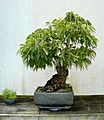National Grove of State Trees facts for kids
The National Grove of State Trees is a special place at the United States National Arboretum in Washington, D.C.. It covers about 30 acres (120,000 square meters) of rolling hills. This grove celebrates the amazing variety and importance of trees from all 50 states and the District of Columbia.
Each state has its own group of trees planted here. The trees are spaced out so they have plenty of room to grow big and strong. You can see many different kinds of trees close together. For example, Bald cypress trees, which usually grow in Louisiana swamps, are just a short walk from pines and birches found in New England forests. Young redwoods from California grow near cottonwoods, which might grow by rivers in the mostly treeless Great Plains states.
Contents
Why Do States Have Official Trees?
Most states chose their state trees in the late 1800s and early 1900s. This was after a time when many forests were cut down. People used the wood for building homes and for fuel. They also cleared land for farms and to raise livestock.
Because so many trees were being cut, people started to worry about protecting forests. They also felt proud of the unique plants in their local areas. This is how the idea of having a special "state tree" was born!
Growing Trees from All Over
The mid-Atlantic region of the United States has mild weather. This means the USDA can grow most of the trees chosen by the different states. However, a few state trees can't grow well here. For example, the cabbage palmetto is the state tree for both Florida and South Carolina. The kukui is Hawaii's state tree. These trees need warmer climates.
To make sure every state is represented, the arboretum uses substitute trees for these species. These substitutes are still important trees from those states.
The planting of the grove began in 1989. Many groups worked together to create it. These included the National Association of State Foresters, the American Forest Foundation, the USDA Forest Service, and the U.S. National Arboretum.
A Special Entrance
The main entrance to the collection is near the M Street Parking Lot in Washington, D.C. There's a beautiful wooden archway called an arbor. This arbor is dedicated to Jeanne Yeutter. She was the wife of Clayton Yeutter, who was a government leader in charge of farming and food. His support helped make the Grove of State Trees a reality.
The words on the arbor say, "In Celebration of Jeanne Yeutter's Love of Trees." The arbor leads to a large open area with a star design made of flagstones on the ground. There's also a wall decorated with pottery tiles. These tiles were designed and made by Liza Bach, an artist from Tennessee. Each tile has the name of a state and a raised picture of its state tree's leaves.
A complete path system is planned to connect all the individual state tree plantings. As of 2004, only a small part of the path was finished. This means most of the collection is not yet easy for everyone to visit, especially those with disabilities.
Images for kids
-
Bonsai persimmon presented to President Ronald Reagan by the King of Morocco in 1983. National Bonsai and Penjing Museum, U.S. National Arboretum
-
Split Ritual by Beverly Pepper










